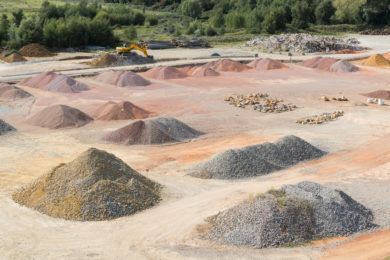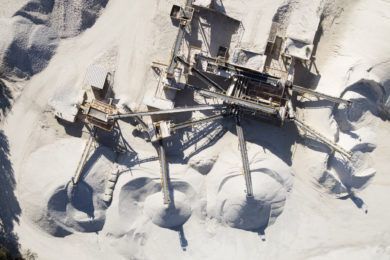While most people think about the construction industry when they hear the word aggregate, the truth is that nearly every product manufactured contains one or more aggregates as their base ingredient. There are even some aggregates — such as barite, bentonite, and calcite – that are valuable to the medical and health industries.
Aggregates are important because of the qualities they possess such as strength, shape, size, texture, bulk, abrasion ability or resistance, medicinal, etc.
For more than 50 years, General Kinematics has provided innovative vibratory equipment that is essential in the mining and aggregate manufacturing process.
A World of Minerals
Most of the products we use every day are made with feldspar, the most abundant group of minerals in the earth’s crust. Feldspars play an important role as fluxing agents in ceramics and glass production and are also used as functional fillers in the paint, plastic, rubber and adhesive industries.
Granite, formed from quartz, feldspar, micas, and other trace materials is used as a road base, filter stone in drain fields, and in the manufacturing of concrete and asphalt.
Dolomite is used for acid neutralization in the chemical industry, in stream restoration projects and as a soil conditioner. It is also a source of magnesia, a feed additive for livestock, a sintering agent and flux in metal processing, and as an ingredient in the production of glass, bricks, and ceramics.
Gypsum, gravel, granite, quartz, pebble, slag and limestone have numerous construction uses. Coal and copper, which are also classified as aggregates, have other industrial applications.
No matter what their use may be, in what shape or form they are found, all raw aggregates must be somehow removed from the earth, transported and processed for further use.
Aggregate Processing
During processing, aggregates are distilled down to a level of their most common use. Some aggregates may be crushed to a powder while others may be screened to various diameter chunks. The proper processing of aggregates is important in maintaining their desirable qualities. For instance, between 60 and 75 percent of concrete consists of both coarse and fine aggregates. If the aggregates are not properly sized, as well as clean and free from other matter, the concrete could fail to meet its desired strength and cause structural failure. Likewise, it is essential that feldspars and dolomite aggregates are processed to their purest forms for effective medical and chemical use.
Companies that process a variety of different aggregates for different uses may have several processing systems and will stockpile each aggregate in separate areas to avoid the mixing of products and preserve the quality of the material.
The first stage of aggregate processing involves quarrying where a large deposit of desirable aggregate is identified and extracted from the ground. Hardened substances are either blasted or cut into smaller manageable-sized rubble and transported by truck or conveyor belts to the processing area.
At the processing site, the aggregates are fed through a crusher, often aided by the GK PARA-MOUNT II® Vibratory Crusher / Feeder. In most cases, a plant will have a primary crusher, which will reduce the size of the quarried rubble down to chunks about six-inches in circumference. The product from the primary crusher is then screened for larger usable products. The remaining material is transported by a conveyor belt to a second GK DIRECT-DRIVE VIBRATORY FEEDER for secondary crushing and screening which is reducing and separating the aggregate into some more usable products. Finally, after tertiary crushing, the GK Aggregate Screen — with single, double, and triple deck configurations — allows for the quick identification and separation of variously sized aggregate for use in concrete and asphalt.
The mining industry has made great strides in extracting deposits and removing the desired material from waste. Mining equipment is now more efficient, saves energy and reduces the number of harmful chemicals needed to extract the desired material from its surroundings. Even still, heavy duty, weather resistant equipment is necessary to extract, transport, and process minerals, ores, and precious metals from soil, sand, and rock.
General Kinematics Processing Equipment
General Kinematics equipment stands out from average aggregate feeders, screeners, and sorting equipment due to GK’s ability to create high performance, low maintenance, and energy efficient machines that are designed to solve the toughest of aggregate process challenges.
GK’s proven track record as mining equipment manufacturers and suppliers can be found in the extensive installation of more than 40,000 vibratory units in nearly every country in the world. GK stands behind its vibrating mining equipment, with unmatched after-sales service and support throughout its global network.
Innovative mining equipment from GK is more compact and able to process material efficiently, increasing an aggregate producer’s ability to invest in superior machinery without breaking the budget. Improvements have also been made in the automation of this groundbreaking mining equipment, making it easier to monitor and maintain more machines while reducing overall man-hours.
If you have a question about any of General Kinematics mining and minerals vibratory feeder, screener, and sorter equipment, contact Chris Andrews, your GK Aggregate Expert today!









